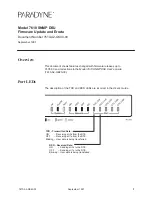
38
Trunking
Trunking, sometimes called Link Aggregation, is a method of paralleling more multiple ports between
two switches. The ability to configure this type of connection will increase the speed beyond the limits
of a single port. The multiple links between switches can also act as a redundant path if one port loses
communication.
Limitations:
• Port 1 cannot be part of a Trunking group
• Ports are not allowed to become members of multiple Trunking groups.
Figure 34. Trunking settings
QoS (Quality of Service)
Quality of Service is a method of prioritizing Ethernet applications or device communications on a LAN.
Once a packet is received by the switch it can take persistence over other packets being received thus
reducing latency and establishing a reliable method of data delivery.
Service quality features four different levels of queue, (High, Middle, Normal, Low). High- priority data
packets stay in the switch for a short time. The data packets are assigned priority levels in accordance to
802.1 priority tag and DiffServ priority tag settings. The QoS full wire-speed mechanism can be
configured using the relative priority and absolute priority
QoS Setup
QoS
Enable - all QoS options become available.
Port Priority
802.1 Priority
802.1 Priority Settings
DiffServ Priority
DSCP Priority Settings
High Queue Preemptive Mode
Port Priority
• Two settings are available, Normal and High. When set to high, the packets have the lowest latency.
















































